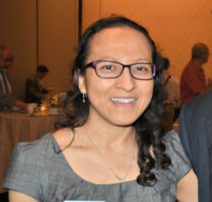
Research physician Dr. Monica Chang-Panesso
Research physician Monica Chang-Panesso, MD, and a team of Washington University nephrology investigators have made significant progress in defining the cellular lineage and molecular mechanism of repair of the proximal tubule after acute kidney injury (AKI). Their study, FOXM1 Drives Proximal Tubule Proliferation During Repair from Acute Ischemic Kidney Injury, five years in the making, was published in the December 2019 issue of the Journal of Clinical Investigation.
There is indeed a pressing need to identify therapeutic interventions to prevent and treat AKI. AKI is a serious, prevalent condition that can lead to long-term kidney damage and is a major cause of morbidity and mortality in hospitalized individuals. In the US from 2000 to 2014, the rate of AKI hospitalizations increased by 230%. As well, patients 66 years and older who were hospitalized for AKI were reported to have a 35% probability of a recurrent AKI hospitalization within one year; 28% were diagnosed as having chronic kidney disease (CKD) in the year following an AKI hospitalization. Nearly 1.75 million of the approximately 10 million people who suffer from AKI each year will die.
The proximal tubule epithelium makes up the bulk of the kidney cortex and is the renal compartment most vulnerable to injury. While it is well known that the proximal tubule has a remarkable capacity for repair after acute injury, the cellular lineage and molecular mechanisms underlying this repair response are incompletely understood.
Dr. Chang-Panesso, assistant professor of medicine, Division of Nephrology, and her team developed a Kim1-GFPCreERt2 knockin mouse line (Kim1-GCE) in order to perform genetic lineage tracing of dedifferentiated cells while identifying the cellular transcriptome of proximal tubule during repair. KIM1 (gene name Havcr1) is a phosphatidylserine receptor that is not detectable in healthy kidney cells. With acute injury, KIM1 is induced in the injured proximal tubules where it binds to apoptotic cells and fragments to clear the tubular lumen of debris.
The group found that upon acute injury, the tubules dedifferentiated and proliferated. Clonal analysis indicated that these acutely injured, dedifferentiated proximal tubule cells, rather than fixed tubular progenitor cells, accounted for the repair of the tubule. They also found that an EGFR/FOXM1- dependent signaling pathway drives proliferative repair after injury.

Friends help Dr. Chang-Panesso’s celebrate the publication of her manuscript in JCI with dinner at Boogaloo restaurant in Maplewood, MO. From left, Drs. Monica Chang-Panesso, Tingting Li, Patricia Kao, Anitha Vijayan, Anuhba Mutneja, and Anuja Java.
The study’s comprehensive transcriptional analysis of proximal tubules during injury is a valuable resource for understanding dedifferentiation, redifferentiation and failed repair at the molecular level.
“This was an exciting and fun project to work on because it used a novel mouse model and well-established genetic approaches to study the injured proximal tubule!” says Chang-Panesso. “We want to gain a deeper understanding from the transcriptional changes in these injured proximal tubular epithelial cells and identify therapeutic targets to enhance renal repair.”
Chang-Panesso’s JCI article has had over 5,000 online downloads. Authors: Monica Chang-Panesso, Farid F. Kadyrov, Matthew Lalli, Haojia Wu, Shiyo Ikeda, Eirini Kefaloyianni, Mai M. Abdelmageed, Andreas Herrlich, Akio Kobayashi, and Benjamin D. Humphreys.
Graduating from Texas Tech University Health Sciences Center School of Medicine in 2009, Chang-Panesso went on to complete a residency at University of Texas Southwestern Medical Center at Dallas and a nephrology fellowship at Brigham and Women’s Hospital in Massachusetts. She joined WashU Division of Nephrology in 2015 and has intensively investigated kidney tubule damage and repair in the Humphrey’s Laboratory. Review Chang-Panesso’s extensive list of research publications here.